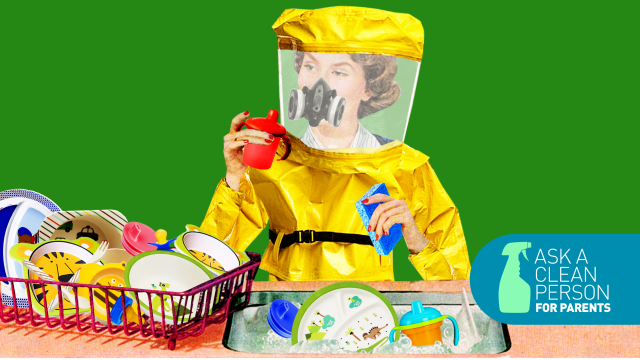Discovering sippy cups filled with old milk is quite gross… so, uh, what’s the best way clean your sippy cups/toddler straw cups?
There are a bunch of easy ways to clean sippy cups that have been sitting with milk in them, or that have developed a lingering smell that regular washing isn’t touching, or in which mould has grown.
Bottle Brushes
One of the trickiest things about sippy cups is getting into the straws, spouts and valves, where milk and juice and backwash gets trapped, creating a lovely home for mould to move into. If you find that you’re frequently struggling to get small sippy cup parts fully clean, a specialty bottle brush set might just be the ticket.
In a pinch, if you’ve got pipe cleaners hanging around the house for arts and crafts projects, you can press one into service to clean out sippy cup straws.
Denture Tabs
Denture tablets have all sorts of great uses beyond cleaning dentures: They can be used to clean vases that have gone gunky after flowers have been left too long, they make a great soak for brightening up fingernails that have gone yellow from overwearing nail polish, they’re the right choice for keeping retainers, nightguards and mouthguards clean. They’re also perfect for dropping in a sippy cup, covering with hot tap water and leaving to do their fizzy, cleaning thing.
Allow the dissolved tab to stay in the cup for 15-30 minutes before dumping out the solution and cleaning the cup with hot soapy water, or running it through the dishwasher.
Denture tablets are especially helpful to use on cups that have sat with a drink in them that’s left a lingering smell behind.
White Vinegar
A reader wrote to me recently about his favourite use for white vinegar:
Yeah, yeah, you might say the following is old news but it’s a new application for white vinegar.
Parents of small children always lose the war against black mould growing inside all those silicone sippy cups, CamelBak valves, and reusable bottle straws.
Parents typically use hot soapy water and miniature bottle brushes, which can fall apart and leave plastic bristles in the kids’ silicone sippy cup parts. As anyone’s dirty shower can tell you, mould grows just fine in hot soapy conditions.
A year ago I started soaking all those silicon drinking container parts in hot water with white vinegar added (one cup of white vinegar to a tap water hot pasta pot of water). No soap, no tiny bottle brush, no fuss and no mould at all since I started.
Great tip!
Dishwasher Baskets
Another problem common to the washing of sippy cups happens in the dishwasher: All those small parts that can fall through the slots in the dishwasher racks. While using the utensil holder that comes standard with you machine is an option, it’s not ideal if it’s a bottom-rack insert, because the bottom heating element can cause plastic to warp or melt.
Enter the add-on dishwasher basket! It can be used in the top rack, away from the heating element, to hold small items like straws and nipples, as well as things like oral syringes and medicine cups.

Comments
One response to “How To Wash Your Kid’s Disgusting Sippy Cups”
My kid once hid her sippy cup of milk, found it in a box of toys a few weeks later, along with mould galore, bagged it all and binned it.